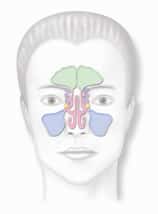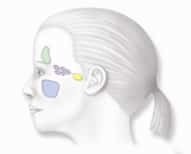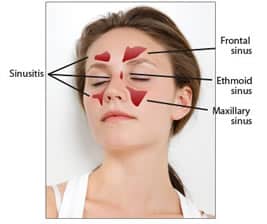Environmental allergies can produce a multitude of symptoms in the head and neck region, including nasal congestion, runny nose, post-nasal drip, itchy throat, sinus pressure and headaches, itchy ears and ear pain. Great Neck ENT provides treatments to minimize allergy symptoms while avoiding the inconvenience of allergy shots in the vast majority of cases. Serving Bayside, Queens, Long Island, and surrounding areas.
Causes of Allergies

Most allergies are inherited. If one parent has allergies, the child has a 50% chance of also having them. If both parents suffer from allergies, the child has a 75% chance. The specific allergen may be different. You may also be at a higher risk for allergies if you have asthma.
Symptoms of Allergies
Most allergic reactions are mild and symptoms include sneezing, runny nose, watery eyes, itching, and a rash. More severe reactions can result in abdominal pain, cramps, vomiting and dizziness. These reactions are rare.
Diagnosing Allergies
Diagnosing allergies is done by evaluating symptoms and a full physical exam. A skin or blood test may be done also. The skin test is done by placing different potential allergens on the skin and then the skin is pricked so the substance can enter the body. If a reaction occurs on the skin, an allergy is diagnosed.
How can Allergies be treated?
The most effective way to treat allergies is to simply avoid exposure to allergens. Other treatments include antihistamines, decongestants, nasal sprays and eye drops. Allergy shots called immunotherapy are also available and help to increase tolerance to allergens. The allergen is injected at increasingly larger amounts to reduce reactions.
What our patients have to say
"I was a new patient for Dr. Werber, seeing him at a time when I was extremely sick. He cared for me as if I had been a long time patient of his. After seeing several other doctors in that same week, it was finally comforting to have someone validate my pain, show compassion and even call me himself the next day to see how I was doing. A few days later when I had an emergency and called for advice, he quickly called me back and sent me to the hospital. It is rare to find someone accessible, professional in his care, and mostly, kind and compassionate. After searching for an ENT for years to find a solution to my ongoing issues, I am grateful to have finally found Dr. Werber."

Sinus Problems
The four sinus cavities, frontal, maxillary, ethmoid, and sphenoid are lined with soft tissue called a mucous membrane and covered with cilia. The lining and cilia protect the body from dust, pollen, germs, and other foreign bodies in the air, and humidifies the air entering in through the nose.
However, such high exposure to environmental irritants can overwhelm the body’s natural defenses and make many people susceptible to a sinus infection or bacteria-nearly 50 million Americans are affected by sinus disorders annually.
Symptoms of a Sinus Problem
Symptoms of sinus disorders vary widely. Infection from colds or sinusitis can result in facial pain and pressure, discolored mucous discharge, or nasal obstruction.
How can a Sinus Problem be treated?
Most people can be treated with antibiotics, i.e. decongestants, antihistamines, and saline sprays, although surgery is an option if pharmaceuticals prove to be ineffective. Other factors such as a deviated septum may necessitate surgical treatment.
Sinus Surgery
Sinus surgery is usually performed to enlarge the openings that drain the sinuses. A patient may choose surgery if other treatments (i.e. medications, nasal sprays, humidifiers, etc.) have failed to alleviate chronic sinus conditions.

Types of Sinus Surgery
Endoscopic Sinus Surgery
The doctor uses a thin fiber-optic tube to examine the openings of the sinuses and remove abnormal or obstructive tissue.
Image-Guided Surgery
Combines CT scans with endoscopic surgery
Usually, these procedures are performed on an outpatient basis. Recovery may include congestion and discomfort.
Nasal Allergies FAQs
There are 4 pairs of sinuses, ethmoid, maxillary, sphenoid, and frontal. In about 5% of cases, the frontal sinuses are underdeveloped.
Mucous membranes that line the sinuses filter, warm and humidify the air we breath.
Sinusitis is caused by viruses, bacteria, and in rare cases, fungi. The infection causes inflammation, which leads to the production of more mucous.
Most sinus infections are caused by viruses and are referred to as ‘colds’. Beneficial treatment includes hydration, decongestants, and saline sprays or irrigation. If the infection is caused by bacteria, treatment with an antibiotic may be necessary.
To read more about how Nasal Surgery relieves Chronic Headaches
Sinusitis and Sinus Headache

Disorders of the sinuses are diagnosed and treated after a careful history is taken and an examination performed. Our conservative approach to the treatment of sinusitis will initially include medication, and if appropriate, allergy treatment. If conservative measures fail to adequately treat a patient’s chronic condition, a CT scan of the sinuses will be requested to diagnose structural blockages and/or polyps obstructing the sinus outflow tracts
If surgery is indicated, the most minimally invasive technique will be utilized, including balloon sinuplasty, endoscopic sinus surgery, and computer image-guided sinus surgery.
Sinusitis is a condition that refers to an inflammation of the lining within the paranasal sinuses.
What causes Sinusitis?
Sinusitis is usually caused by bacteria, a virus, or allergies.
What are common symptoms of Sinusitis?
Sinusitis can be classified by location:
- Maxillary – which causes pain or pressure in the cheek area;
- Frontal- which causes pain or pressure above and behind the eyes;
- Ethmoid – which causes pain or pressure between or behind the eyes; and
- Sphenoid- which causes pain or pressure behind the eyes.
Sinusitis FAQs
Chronic sinusitis occurs when inflammation of the mucous membranes lasts for more than 3 months.
Symptoms of chronic sinusitis include persistent nasal congestion, facial pressure, headaches, nasal discharge, postnasal drip, cough, and a reduced sense of smell.
Ear, nose and throat specialists use an endoscope to examine the inside of the nose and sinuses. A CT scan may be indicated to look for structural issues affecting the drainage of the sinuses.
Treatment may include antibiotics, sometimes for prolonged periods, nasal steroid sprays, saline nasal irrigation, and oral steroids. In some cases, a procedure to ‘open’ and drain the sinuses may be necessary.
